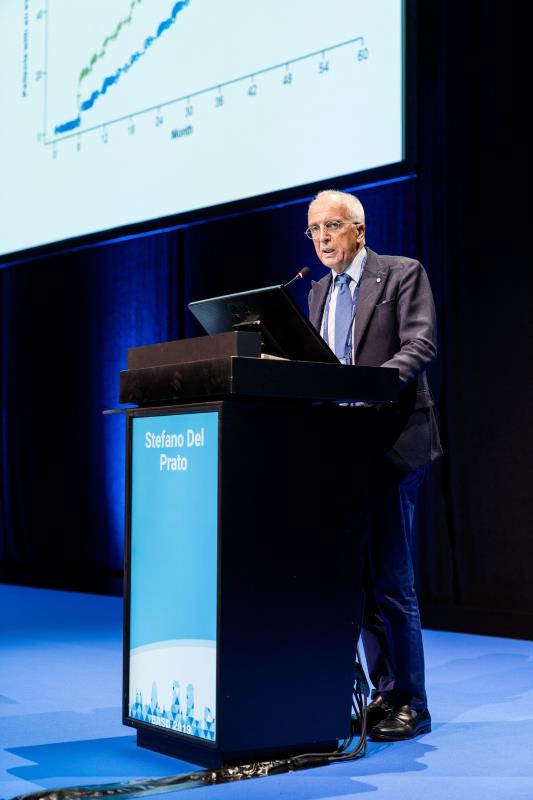 Prof Stefano Del Prato
Prof Stefano Del PratoUpfront combination therapy with metformin and the DPP-4* inhibitor vildagliptin may improve glycaemic durability in patients newly diagnosed with type 2 diabetes (T2D) compared with sequential therapy with metformin monotherapy followed by vildagliptin, results from the VERIFY** trial showed.
“An early combination treatment strategy significantly reduced the relative risk of time to initial treatment failure by 49 percent [vs monotherapy],” presented study author Professor Stefano Del Prato from the University of Pisa in Pisa, Italy, at EASD 2019.
This multinational (34 countries), double-blind trial involved 2,001 treatment-naïve*** adults who had been diagnosed with T2D within 2 years pre-study and had an HbA1c of 6.5–7.5 percent (mean 6.7 percent) and BMI of 22–40 kg/m2. After 3 weeks on metformin alone (target dose 1,500 mg/day or maximum tolerated), they were randomized to receive early combination therapy (metformin at 1,000, 1,500, or 2,000 mg/day plus vildagliptin 50 mg BID; n=998; mean age 54.1 years) or continue metformin monotherapy (1,000, 1,500, or 2,000 mg/day; n=1,003; mean age 54.6 years; study period 1).
Patients on metformin monotherapy who had initial treatment failure – failure of initial therapy to reduce HbA1c to <7.0 percent at two visits 13 weeks apart – had vildagliptin 50 mg BID added to their regimen (study period 2). Patients were followed up for a median 59.8 months.
Fewer patients on metformin plus vildagliptin than metformin monotherapy were treatment failures during study period 1 (43.6 percent vs 62.1 percent). [EASD 2019, abstract S23.3; Lancet 2019;doi:10.1016/S0140-6736(19)32131-2]
Median time to treatment failure was 36.1 months in the metformin monotherapy group and was estimated as beyond study duration in the metformin-vildagliptin group (estimated 61.9 months).
The relative risk of time to initial treatment failure was halved with combination therapy over metformin monotherapy over the 5-year study period (hazard ratio [HR], 0.51, 95 percent confidence interval [CI], 0.45–0.58; p<0.0001), as was the risk of time to second treatment failure in study period 2 when all patients who had experienced treatment failure were receiving vildagliptin-metformin (HR, 0.74, 95 percent CI, 0.63–0.86; p<0.0001).
More patients who initially received combination therapy consistently achieved HbA1c levels of <7.0, <6.5, and <6.0 percent over the study period than those on metformin monotherapy.
Adverse event (AE) incidence was comparable between the combination and metformin monotherapy groups (83.5 percent vs 83.2 percent), as was serious AE incidence (16.6 percent vs 18.3 percent). The most common AEs were arthralgia (10.0 and 9.4 percent in the combination and metformin monotherapy arms, respectively) and urinary infections (7.3 and 7.1 percent, respectively). Incidence of hypoglycaemia, pancreatitis, and pancreatic carcinoma was low. None of the 22 deaths were deemed study drug-related.
Both approaches were safe and well tolerated. Adding on a second drug earlier does not increase the risk of side effects, said Del Prato.
Exploratory analyses showed a numerical but not statistical reduction in cardiovascular (CV) events with early combination treatment over metformin monotherapy. As such, the authors called for further research to investigate the CV effects of early combination treatment as VERIFY was not powered to assess this outcome.
Long-term effects = far-reaching outcomes
“Collectively, early combination therapy with metformin and vildagliptin seems superior to sequential intensification of metformin in patients with recent onset of diabetes with mild hyperglycaemia,” commented Professors Ofri Mosenzon and Gil Leibowitz from the Hadassah Medical Center, Hebrew University of Jerusalem, Jerusalem, Israel. [Lancet 2019;doi:10.1016/S0140-6736(19)32165-8]
Nonetheless, further research is needed to establish the efficacy of early combination treatment in stopping diabetes progression, they said.
“VERIFY has shown that we can consider earlier and better glycaemic control … and that glycaemic control can be more durable and can be retained for a longer time [with combination therapy],” said Del Prato. The vildagliptin-metformin combination was also not associated with any side effects and without hypoglycaemia or weight gain, all of which could have significant implications for patients, he added.
“Real-world evidence has shown how delayed treatment intensification after monotherapy failure results in increasing time spent with avoidable hyperglycaemia, raising a crucial barrier to optimized care,” noted the authors.
“If you can achieve glycaemic control without increasing the risk of side effects, you can also expect patients to be more adherent to treatment,” said Del Prato. The long-term durability of glycaemic control could also potentially reduce clinical inertia.
It also remains to be seen if the early combination strategy is applicable to all patients with T2D, said Mosenzon and Leibowitz. Seeing as how 40 percent of VERIFY patients on metformin monotherapy did not experience treatment failure, upfront combination therapy may lead to overtreatment in some patients. “In the emerging era of precision medicine, better stratification of the individual risk factors for diabetes progression and complications will be required for personal tailoring of treatment,” they said.